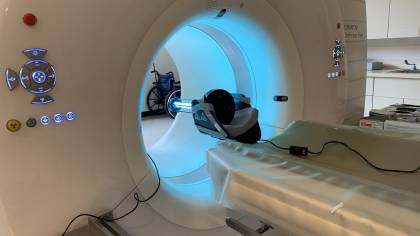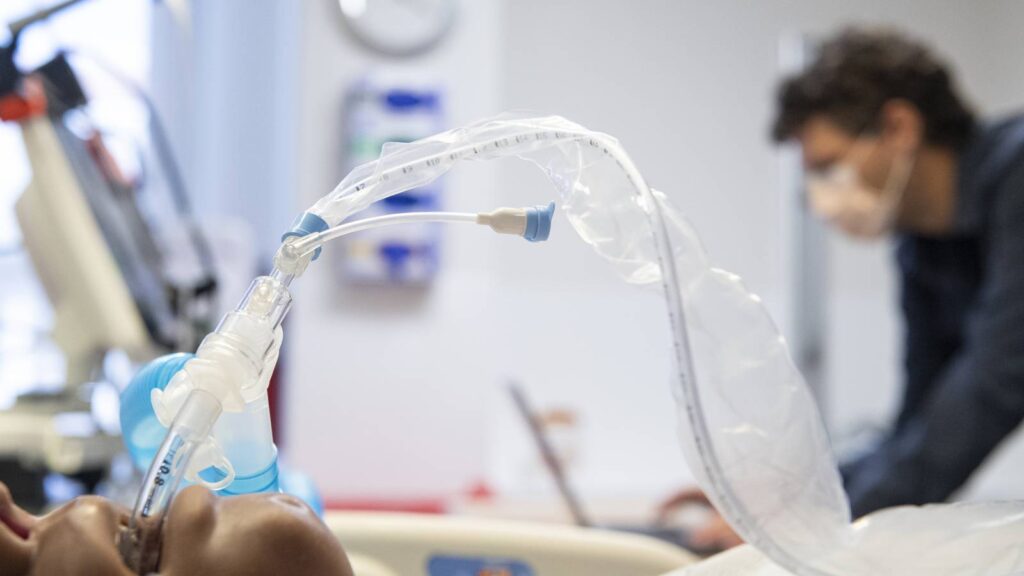On March 23, 2020, as COVID-19 overwhelmed New York City’s hospitals, Greg Hager gathered roughly 40 colleagues on a Zoom call and told them, “If we’re going to think of this as a new challenge in health care, let’s think about the ideas and resources we can bring to the table that might be of help.”
He was talking to the right people. At the time, Hager, a computer science professor, was also founding director of Johns Hopkins Malone Center for Engineering in Healthcare. Comprised of 50-plus Hopkins faculty with expertise in engineering, technology, and medicine, the center’s name just about sums up its mission—using research-based innovations to optimize health care.
But the COVID-19 pandemic—hobbling patients, front-line workers, and hospitals—was unlike anything they’d experienced. “All of it,” Hager recalls, “was totally new.” A year and half later, the center’s COVID-19-focused efforts have resulted in roughly 20 projects turning the “new” into the manageable while demonstrating the resourcefulness of the Malone Center’s brain trust.
“As a person, I was nervous about where things were going,” recalls Kimia Ghobadi, a COVID-19 team member and professor of civil and systems engineering. “But as an engineer, somebody trained to make systems efficient and make use of available capacity, I was very excited.”
During that initial call, just 12 days after Hopkins suspended its in-person classes, the group divided the Malone Center’s COVID-19 efforts into nine “problem areas,” ranging from short- to long-term, and began forming teams to address them. Among the areas were: capacity management; healthcare provider safety; data analysis; diagnostics; and robotics. The center has experts in those areas, so Hager didn’t need to micromanage.
“I was just trying to connect the dots between them and, in some cases, help them find resources they needed,” he recalls.
The approach worked. “He puts people in touch and lets self-organization happen,” Axel Krieger, an assistant professor of mechanical engineering, says of Hager. “And he’s informal. It’s more like, ‘Hey, meet so-and-so, you might be able to help.'”
One hub in the network was Scott Levin, an associate professor of emergency medicine. Although he’s an engineer, not a medical doctor, among his colleagues are physicians and nurses who, in spring 2020, were facing challenges including shortages of personal protective equipment and concerns about infections.
Because hospitals were under such duress and limiting visitors, Levin arranged teleconference calls between his colleagues and Malone Center members seeking to ameliorate the situation. “I was a liaison for engineers who’d otherwise find it hard to connect with the front line,” he says.
Ghobadi, who was on several calls, focused on managing capacity at Hopkins’ five hospitals. If one were to be inundated with too many COVID-19 patients, then equipment shortages, high infection rates among caretakers, and the neglect of non-COVID-19 patients might follow. But the problem couldn’t be fixed overnight. “When a disaster hits, the last thing people can do is change their methods and the way they’re dealing with it,” she explains.
Instead, with the help of her students, Ghobadi began to gather data on each hospital’s level of preparedness—beds, equipment, ICU capacity—as well as its numbers of COVID-19 and non-COVID-19 patients. She then formulated mathematical models aimed at “load-balancing” the entire Hopkins network, or transferring patients between hospitals to prevent overcrowding.
“If we know a surge of COVID is coming and we know hospitals’ capacities, we can transfer patients before they’re full,” she explains. “That leads to better care for patients since they don’t have to be moved mid-care, which means staff won’t be overwhelmed admitting patients who might have been transferred later.”
Gathering data outside of the Hopkins network wasn’t as easy. But after several months, Ghobadi’s team was able to introduce a new online tool, the Covid-19 Capacity Management Dashboard, which keeps tabs on capacity nationwide, enabling patients and professionals to monitor up-to-date information on local hospital networks.
While she hasn’t tracked who’s using the dashboard outside of Maryland and Washington, D.C., Ghobadi says it and her models have produced positive results within Hopkins’ system. Transfers have increased 30% in the past year, mostly among emergency departments, where they’ve risen by 80%. “That’s a sign of a change of attitude in using patient transports to stay ahead of overcrowding,” she says.
Part of the capacity equation is determining who needs COVID-19 care, and how much. Using electronic health record data, Levin and his Malone Center team devised an AI-driven “scoring system” for Hopkins patients. While in the emergency department, their data—including symptoms, vital signs, and medical history—is fed into an algorithm that estimates each patient’s risk level, ranging from one (the lowest) to 10.

Image caption:Malone Center faculty member Jeffrey Siewerdsen co-developed a system to decontaminate CT scanning machines using UV-C light—a process still in operation in health care settings during the pandemic.
Levin was asked to develop the tool after Baltimore set up a field hospital for COVID-19 patients who don’t need acute care but can’t yet return home. “We translate that risk level,” he says, “to where the patient should go—home, the field hospital, the intensive care unit, or a normal floor bed.”
Hopkins doctors found the system so useful that Levin put together a presentation for the U.S. Centers for Disease Control and Prevention with the aim of sharing research that might help hospitals elsewhere operate more efficiently. In fact, he and several Malone Center members—including Hager and Ghobadi—co-authored a paper in Surgical Innovations providing an overview of the center’s COVID-19 efforts. It includes highlights of impactful projects in three categories: data, devices, and systems.
Krieger, another co-author, had a hand in developing the highlighted devices, one deployed during the pandemic—a mobile COVID-19 testing booth which, via pressurization and filters, allows health care workers to conduct tests safely. Approved by the city of Baltimore, the booths have been used in several locations, according to Krieger, who also co-designed other devices aimed at protecting front-liners.
One, a see-through, acrylic-and-rubber “hood” enveloping a patient’s head, reduces exposure to COVID-19 as they perform airway management procedures, including intubation. Krieger also co-designed two remotely-operated robots—one capable of changing ventilator settings, the other of conducting CT scans to check for COVID-19.
All three devices were successfully tested, and Krieger co-authored a paper showing that robots designed by his teams and others could be used to perform various medical tasks in infectious-disease situations. But such devices are subject to federal approval, and the approval process, when it comes to university-generated research and devices, “is just not geared for really rapid development,” Krieger says. He and his fellow engineers acknowledge, however, that they didn’t necessarily intend for their projects to have immediate impact.
“Engineering is a process where you need to have the real problem in front of you,” says Hager. “You need to develop something, then observe, experiment, and improve, to optimize as you understand how the solution you’re developing exhibits itself in the real world.”
Accordingly, the Malone Center engineers hope their ongoing research—still relevant in light of the pandemic’s latest challenges—will prepare hospitals for future dilemmas. Says Levin: “In the emergency-preparedness world, whether it’s a pandemic, natural disaster, or terrorism, it comes down to, ‘Are you doing this as your routine practice?’ If so, you’ll be ready. If not, you can suffer some of the same challenges.”
The Malone Center, to a great extent, was ready. Hager, who, after several years, intended to step down as director in early 2020, stayed on when COVID-19 hit. In early July, he handed the reins over to the Joel Bader, a professor of biomedical engineering.
“The center’s mission remains a focus on improving health and health outcomes,” Bader says. “The pandemic created a set of urgent new problems and societal needs that our faculty recognized and responded to. There will never be a top-down mandate to refocus their research on an urgent need, but there will always be support for faculty who engage in that need and move their research in new directions.”
